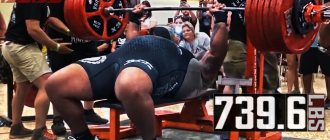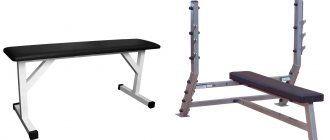The bench press is truly multifaceted, some are pursuing their cherished dream of benching 100, and some are already 150. But there is also a person like Kirill Sarychev, who conducts his everyday training with a weight of 255 kg, which is far from the limit for him. After all, Kirill is the holder of the world record for this discipline (335 kg!), which he set in November 2015. We came to the famous powerlifter's gym and watched how he trained, and also received a lot of useful advice.
A heavyweight like Kirill Sarychev doesn’t need much time to warm up, but he nevertheless warms up quite actively with hyperextension, as well as various exercises for the chest, shoulders and triceps. Note that even the holder of the world record for bench press prefers to start his workout with an empty bar.
The path from 100 to 150kg
- Don't train to failure. Many people, having achieved the coveted 100 kg in the bench press, are now seriously thinking about how to get to the point of 150 kg. Kirill Sarychev considers overtraining to be one of the main obstacles on the way to new records. The majority, in pursuit of the desired result, almost always work to failure, without sparing themselves. This is very commendable, but not entirely, so to speak, competent.
- Don't get carried away with the utility room. Some also mistakenly add a lot of accessory exercises and do them with all their strength. It simply “kills” your nervous system. In a month, you can fully feel overtraining, after which you will certainly not be interested in records.
- 4 training days. Kirill Sarychev does 5 working approaches of 2 repetitions. For example, the same workers 255 kg, our record holder can bench press 9 times. Kirill Sarychev recommends two bench press days a week, as well as a day for training the legs and back, which can be diluted with additional work.
How to find out the maximum working weight in an exercise
As we have already found out, calculating the maximum working weight in isolation exercises does not make much sense (especially when it comes to training beginners ), so you should concentrate all your efforts on calculating in basic exercises (this is, first of all, deadlifts, squats with barbell and bench press)
1 way
To calculate the maximum in an exercise, you can use the universal formula : perform the exercise with the correct technique in 5 sets of 6 repetitions and multiply the working weight by a factor of 1.2, the resulting figure will be your maximum weight.
It is necessary to perform it so that after 5 approaches, you cannot complete the 6th approach fully, without violating the technique, for all 6 repetitions due to the resulting muscle stress (fatigue).
Let's say you're in the gym, you did a deadlift with a weight of 120 kg for all 6 reps in 5 sets, so in the 6th set, if you were doing it, you wouldn't be able to do it for all 6 reps (5 or 4), total we get our maximum deadlift: 120 * 1.2 = 145 kg approximately.
Method 2
Perhaps someone doesn’t like such a rough calculation, then in this case, you need to warm up thoroughly, do a full warm-up, and through experimentation , adding weight to the barbells in increments of 5-10 kg, lift the weights until you reach your maximum .
Adjusting the weight on the bar when calculating the weight lifted per time in increments of 5-10 kg , is more relevant to isolating exercises, and basic exercises when you approach your limit ( submaximal weights). Typically, athletes begin to use steps of 20-30 kg , both during warm-up approaches and when calculating their maximum.
How to find out the maximum working weight in an exercise
For example, let’s calculate the working weight in a basic leg exercise – squatting with a barbell on the shoulders:
We know that an athlete assumes that he can squat with a barbell for about 110-120 kg , it is necessary to calculate how much he can actually squat if a regular leg workout of medium intensity looks like this:
- 4 sets of 8 reps, with a weight of 90 kg.
In order to determine how much weight an athlete can lift a barbell with, it is necessary to first warm up using an empty bar, light weights and a warming ointment for the muscles (optional).
- 1 set of 15 reps with empty bar
- 1 set of 12 reps with 40 kg
- 1 set of 8 reps with 60 kg
- 1 set of 4 reps with 80 kg
- 1 set of 2 reps with 100 kg
- 1 set of 1 rep with 110 kg
- 1 set of 1 rep with 115 kg
- 1 set for 1 rep from 117.5 - 120 kg (hardcore)
The maximum will be considered to be the weight that you can lift 1 time without grossly violating the execution technique.
Thus, the resulting figure can be used in all training programs that mention percentages of the maximum working weight in a specific exercise.
3 way
Use various online calculators , or applications from the play market, which often use the formulas of Brzycki, Apley, Lander, Lombardi, Mayhew, O'Connor, Vatan. However, the accuracy of these programs leaves much to be desired.
The most proven way to calculate the maximum is the one that is carried out practically , by actually feeling the weight lifted, that is, method No. 2.
Technique and auxiliary exercises
When bench pressing, the grip should be as strong as possible. Try to bring your shoulder blades together and distribute the load evenly across all involved muscles. Even if you have more developed pectoral muscles, make sure that your triceps also get their share of the load. If your arms are lagging behind, you can add a triceps exercise with a straight stick on a block, but, for example, Kirill does not recommend the French press, considering it quite traumatic.
Also, don’t forget about your shoulders; a standing barbell press would be an excellent auxiliary exercise. Self-control is important in all auxiliary exercises; try to avoid unnecessary stress. An important element in the bench press are the legs. They should not just stand on the floor, but rest well against it, creating a kind of spring.
The bench press varies
There are two main variations of the classic flat bench press:
- bodybuilding;
- powerlifting.
The latter is aimed at maximum results in one repetition, no matter how you achieved it. For example, techniques are used to reduce the range of motion, such as the “bridge”:
Also, in addition to the pectoral muscles, absolutely all possible assistant muscles are used to the maximum, starting with the legs, continuing with the back and ending with the triceps and deltoids. Compared to the bodybuilding version, the movement is similar, but at the core it is completely different.
Of course, with increasing strength, the volume of the pectoral muscles also increases, but developing them with the help of powerlifting is like hammering pushpins with a sledgehammer. Traumatic and meaningless. Perhaps, for variety, sometimes you can try power penetrations, but no more.
In this material, I will talk specifically about the bodybuilding version of the bench press, increasing strength indicators and effective chest training in general, which will require a number of other exercises.
However, if you want to work towards powerlifting, start with Yuri Belkin's :
And the nuances of the power bench press from him:
Powerlifter nutrition
If you want to achieve results specifically in the bench press, then you should not be afraid of cardio. Within reasonable limits, cardio exercise will help you maintain the desired shape. There is a stereotype that powerlifters don't watch their diet as much as bodybuilders. The latter actually calculate calories more carefully, and in general spend completely different amounts on food. However, a powerlifter should in any case avoid fast food, not overeat sweets and, of course, avoid eating before bed. If you sometimes find it difficult to resist junk food, then the best option would be to consume it before, during, or immediately after training.
On November 19-20, Moscow will host the sports festival and sports nutrition exhibition SN PRO 2016, where 9 strength tournaments will take place at once. Kirill Sarychev will be one of the main characters of this event.
#bench press #Kirill Sarychev #Powerlifting #record #training
Previous 7 actors who rocked up for a new role
Next Famous jocks in childhood and youth
Leave a comment (Cancel)
How to increase your bench press?
Want to learn how to quickly increase your bench press results? Then read the article “How to increase your bench press?”...
Many athletes are concerned about how to increase their bench press. After all, you will probably agree that doing this is not as easy as you think.
Because for some time your bench press is growing well and you throw more and more new weights on the barbell and think that this will continue forever.
But then one fine day, you come to the gym and realize that you can’t add more and that you can’t do it the way you used to.
And you realize that you are stuck with your 100 kg bench press for a very long time. And no matter what you do, your bench press will not grow.
Some people get stuck on larger scales, and others on smaller ones, but the fact remains that you have reached a “plateau”...
Well, now perhaps the main question is how to overcome it and start progressing again?
I will not write banal things about how you need to eat more or rest more and similar nonsense. I will write to you what I did to overcome the “plateau”, and you decide whether to do the same or not...
At one time, just like you, I was stuck on different scales. First at 80 kg in the bench press, then at 100 kg. Then already at 110 kg, but then I made a very quick jerk and was able to reach first 140 kg, and then 175 kg.
Moreover, I achieved these results without taking pharmacology or any other drugs. Therefore, I know what a “plateau” is and I know how to deal with it...
Of course, I can’t boast of a big bench press, because I’m not a bencher or a powerlifter.
But using my training principle, I got to the point where I was able to bench press two of my weights, as well as pull and squat more than three of my weights.
For professional powerlifters, such results mean nothing. But I’m not writing for them now.
And for 95% of training people, whose maximum weight in the bench press is not 250 kg or even 300 kg, but much more modest and varies between 100-150 kg.
I understand that everyone wants to bench press 200, 250, and even more so 300 kg. But let's be realistic and first get to our more realistic scales, and then look at other weights.
According to statistics, only 5 people out of 100 can bench press more than 150 kg. Some people can squeeze a maximum of 100 kg, some 120 kg, some 140 kg and even 150 kg. Well, someone now benches a maximum of 80 kg.
And that's okay! We all started small...
Therefore, first of all, I am not writing for those who bench press 250-300 kg, because there are only a few of them, but I am writing for those whose goal is 100, 140 or 180 kg, or even just 80 kg.
Although if you bench press more than 150 kg, then this material will also be very useful to you, because you will learn how to move on to new weights of 200 and even 250 kg.
Because all the principles of training are essentially the same. The main difference is whether you work natural or pharmacologically.
My main goal is to teach you how to train naturally. In order for you to reach at least 1.5-2 of your weights in your bench press. Because these are real indicators, and then see for yourself.
When you have a natural base and you have already reached 2 of your scales. Believe me, with pharmacology, you can very quickly reach 2.5 and even 3 of your weights.
And if you start using steroids already at 80 kg or 100 kg in the bench press, then most likely you will add another 15-20 kg in the bench press. But you will never reach 2-3 of your scales. And all because you don’t have any training base or system.
Because the main thing in all this is not steroids, but systematization and proper planning of your training. If you don’t have proper planning, you simply won’t get results.
Chaotic and incomprehensible workouts never bring serious results. You will continue to stomp on the same scales all your life...
Therefore, first build a competent training system, and also get good results, and only then think about taking pharmacology.
Find out how to build a competent training program here...










